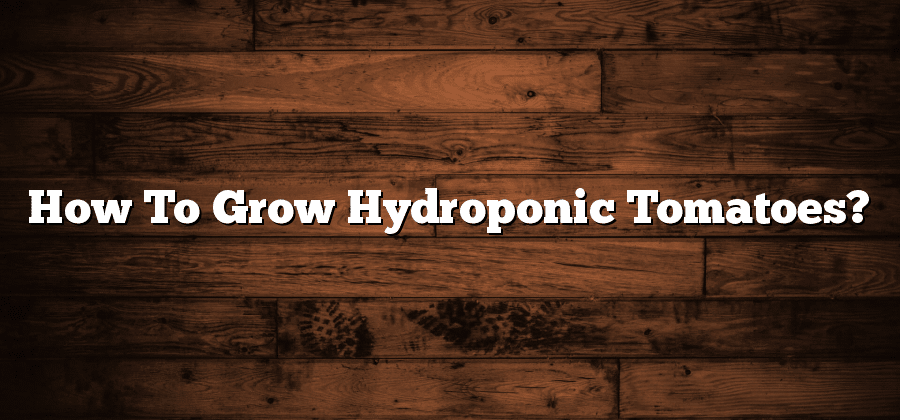Selecting the Right Tomato Varieties
When it comes to selecting the right tomato varieties for your hydroponic system, there are a few key factors to consider. First and foremost, think about the specific purpose for your tomatoes. Are you looking to grow tomatoes for salads and fresh consumption, or do you plan on canning or making sauces with them? Different tomato varieties have distinct flavors and textures, so it is important to choose a variety that aligns with your culinary preferences.
Secondly, take into account your local climate and growing conditions. Some tomato varieties thrive in hot and sunny environments, while others are better suited for cooler climates. Consider the average temperatures, humidity levels, and the length of your growing season. By selecting a tomato variety that is well-adapted to your specific climate, you can maximize your chances of achieving a successful harvest.
Lastly, think about the specific characteristics that you desire in your tomatoes. Would you prefer large and meaty tomatoes, or are you looking for smaller cherry or grape tomatoes? Additionally, consider factors such as disease resistance, fruit yield, and growth habit. By evaluating all these factors, you can select tomato varieties that are best suited for your hydroponic system and personal preferences.
Understanding the Basics of Hydroponics
Hydroponics is a modern gardening technique that has gained popularity in recent years. It involves growing plants without the use of soil, instead using a nutrient-rich water solution to provide the necessary sustenance. This method offers various advantages, including faster growth rates, higher yields, and better control over environmental factors.
One of the key principles of hydroponics is the idea that plants obtain their nutrients from water, rather than from the soil. This is achieved by providing a carefully balanced nutrient solution directly to the plant’s root system. By bypassing the soil, growers can ensure that the plants receive all the essential elements they need for optimal growth. This level of control over nutrient availability is one of the main reasons why hydroponics has become so popular among both commercial and home gardeners alike.
Creating the Ideal Hydroponic Environment
In order to maximize the success of your hydroponic tomato growing venture, creating the ideal hydroponic environment is of utmost importance. Several key factors must be considered to ensure optimal growth and development of your plants.
First and foremost, maintaining the proper temperature is crucial. Tomatoes thrive in an environment with temperatures ranging between 70-75 degrees Fahrenheit (21-24 degrees Celsius) during the day, and slightly cooler temperatures of 65-70 degrees Fahrenheit (18-21 degrees Celsius) during the night. Inconsistent or extreme temperatures can hinder growth and potentially damage your plants.
Furthermore, lighting plays a vital role in the hydroponic environment. Tomato plants require a minimum of 12-16 hours of light each day to grow successfully. Investing in high-quality grow lights, such as LED or high-intensity discharge lights, can provide the necessary intensity and wavelengths needed for photosynthesis. Additionally, monitoring the distance between the light source and the plants is essential to prevent burning or inadequate light penetration.
Preparing the Hydroponic System
To successfully grow hydroponic tomatoes, careful preparation of the hydroponic system is crucial. The first step is to clean and sanitize all the containers, tubes, and any other equipment that will be used in the system. This ensures that the growing environment is free from harmful bacteria or pathogens that could potentially harm the plants.
Next, it is important to set up the necessary components of the system. This includes installing the water pump, air stones, and nutrient reservoir. Each component should be securely placed to prevent any leaks or malfunctions that may disrupt the growing process. Additionally, it is essential to properly connect the tubes and ensure that there is a smooth flow of water and nutrients throughout the system.
The preparation phase of the hydroponic system sets the foundation for successful growth. By thoroughly cleaning the equipment and carefully setting up each component, growers can create an optimal environment for their hydroponic tomato plants.
Planting Hydroponic Tomato Seeds or Seedlings
Once you have selected the right tomato variety for your hydroponic garden and have set up the ideal environment, it’s time to move on to the next step: planting the tomato seeds or seedlings. This crucial stage requires precision and attention to detail to ensure successful growth.
Whether you choose to sow tomato seeds directly into your hydroponic system or transplant seedlings, proper care and technique are key. If you opt for seeds, make sure to handle them with care and place them in a growing medium that provides optimal moisture and nutrients. On the other hand, if you decide to use seedlings, gently remove them from their containers, taking care not to damage their delicate roots, and ensure they are appropriately spaced within the hydroponic system. By following these steps correctly, you will set the foundation for healthy and productive tomato plants in your hydroponic garden.






